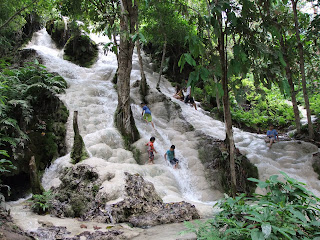One of the most unique places we’ve ever been to in Thailand is called Bua Tong or the Sticky Waterfalls. Located about an hour and a half drive north of Chiang Mai’s Old City, these waterfalls are not only impressive and gorgeous, but a special feature allows you to climb directly up the rocks into the oncoming cascading water.
Although waterfalls are a common tourist attraction in Thailand, we’ve hadn’t seen this one listed in a guidebook. In fact, like many fun things we’ve done, this trip to the Sticky Waterfalls was recommended by a good Thai friend. This was an awesome addition to our trip to the Mae Ngat Dam floating houses one weekend.
Waterfalls are notoriously slippery. One usually goes down a waterfall thanks to gushing waters and slick surfaces. So how is it possible to climb up the Sticky Waterfalls?
The Sticky Waterfalls get their name from a mineral deposit that is incredibly grippy. In fact, the rocks feel like a hardened sponge. They are callous and even slightly prickly to the touch but surprisingly give a bit under pressure. Since no algae or slime adheres to the rocks, they are the perfect canvas to climb up the waterfall. It is impressively steep in some places, but with the aid of the limestone deposits on the stones, we felt like Spider-Man!
Brawn and Beauty
The Sticky Waterfalls are an impressive sight. The rocks are cream-colored and bulbous, almost cartoonish, and contrast beautifully with the dark green forest. And the water? Crystal clear and cool. It comes from a mineral spring so the waterfall is present year-round.
The surrounding forest floor is coated with moss and small colorful flowers. There are plenty of forest creatures like butterflies and water bugs, and there are even the occasional minnows.
These multi-tiered waterfalls are easy on the eyes and a great way to cool off in Thailand’s heat. They are a challenge to your muscles, though. If you do plan to climb these waterfalls, be prepared to work muscles in your legs and feet you never knew existed. Even if you don’t plan on getting wet clambering over the rocks, there are a couple hundred steep stairs that take you down the various levels of waterfalls. Make sure to save your energy for the trip back up!
Stay for a Picnic
Located in the Sri Lanna National Forest (pronounced See Lanna), the Sticky Waterfalls is a great place for a picnic. There are drinks and light snacks for sale on the premises and clean (although Thai-styled) bathrooms. Food is not allowed down in the waterfall area. However, there are plenty of picnic tables with shade near the top area of the park entrance.
Alternatively, about a five minutes drive before arriving at the park is a small outdoor market with several open-aired restaurants. Vendors can whip up Thai meals to-go that you can take with you to the park. There are also grilled meats, fresh fruits, and some small packaged Thai snacks that are perfect for picnicking.



